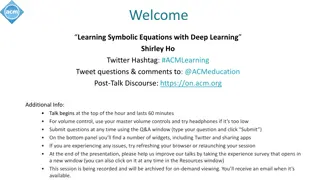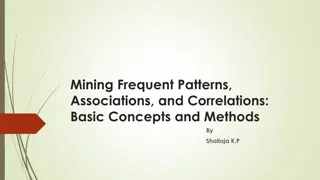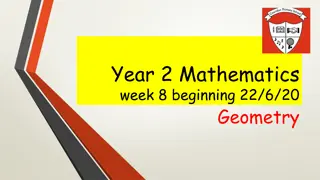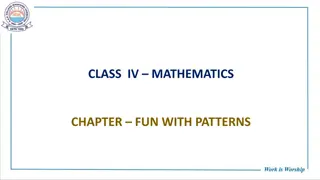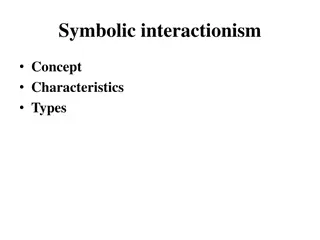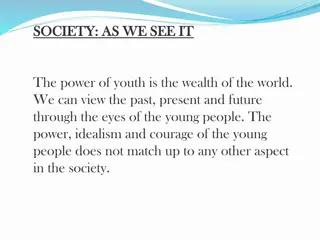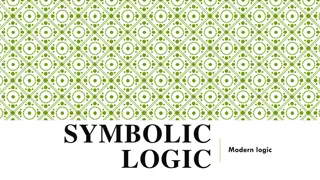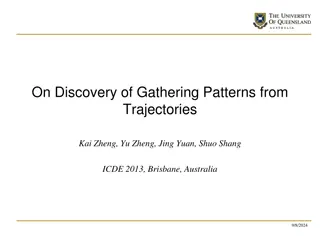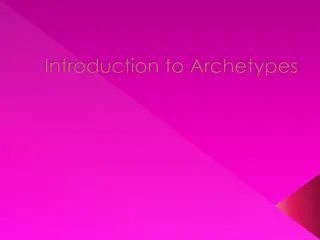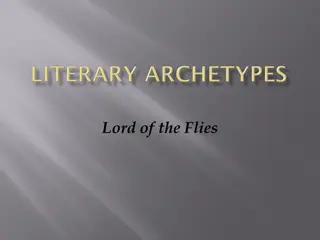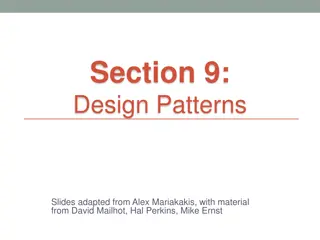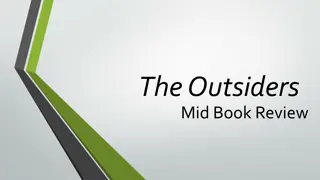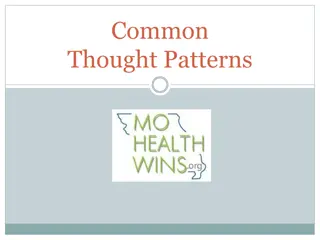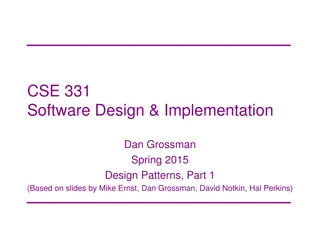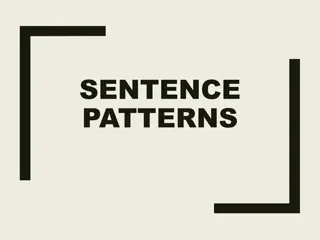
Symbolic Forms and Archetypes: Patterns in Language, Art, and Music
Explore the diverse symbolic forms and archetypes in language, visual art, and music as discussed in Wolfgang Wildgen's contribution to a conference in Florence. Delve into the fundamental structures and mathematical relationships underlying these symbolic forms, raising intriguing questions about their origins and interactions across different genres.
Download Presentation

Please find below an Image/Link to download the presentation.
The content on the website is provided AS IS for your information and personal use only. It may not be sold, licensed, or shared on other websites without obtaining consent from the author. If you encounter any issues during the download, it is possible that the publisher has removed the file from their server.
You are allowed to download the files provided on this website for personal or commercial use, subject to the condition that they are used lawfully. All files are the property of their respective owners.
The content on the website is provided AS IS for your information and personal use only. It may not be sold, licensed, or shared on other websites without obtaining consent from the author.
E N D
Presentation Transcript
Wolfgang Wildgen Symbolic forms and Archetypes. Basic Patterns in Language, Visual Art and Music CONTRIBUTION TO THE CONFERENCE IN FLORENCE, "Structures M res. Semantics, Mathematics and Cognitive Sciences , 10.-12. MAY 2017
Introduction The disciplines beyond physics, such as biology, psychology, linguistics, sociology came into the reach of mathematical methods and the discussion in Kant had to be enlarged: How is knowledge in biology, psychology, linguistics beyond empirical description possible and what kind of mathematics, which province or subfield of mathematics should be the intellectual instrument of such knowledge. 2
The diversity of symbolic forms and the search for fundamental structures ( structures m res ) 1. If we consider a plurality of symbolic forms, is there a set of basic principles (archetypes) governing the different genres of symbolic forms? 2. We will argue that the archetypes of the genres of symbolic forms can take profit of some mathematical tools but that they are not related to unification programs inside mathematics and logics. 3
There are two major questions left: (1) Does the human capacity to use and invent symbolic forms which has led to different genres have a common source, a general denominator? In an evolutionary perspective the roots may even lie beyond the human species and may have emerged later given the specific conditions created by human evolution (e.g. with the rise of large scaled cultures). (2) How did theses genres of symbolic forms which may have existed and coevolved during long periods interact? Could this co-evolution explain the easiness of blends between the different genres? 4
A set of regular polygons (above), the di-hedron(middle; square with rotation on the axis) and the regular polyhedrons (Platonic solids) 5
Basic strategies of modelling The abstract geometrical character of basic representations is not only metaphorically valid; looking at results in neurophysiology and in the psychology of vision the relevance of spatial and "imaginistic" analyses for cognition, memory and language become evident. The basic problem in the transition between perception - cognition - motor control is the proper mapping from one internal representation to the other. The mapping must conserve basic topological and dynamic characteristics and can forget metrical details, variations of a type of object or event. Three types of singularities are primary: a. regular points (Morse-points); they do not qualitatively change under perturbation; we may say that they have a static identity (of self-regulation), b. fold-points (a frontier line between a stable and an unstable domain appears), c. cusp-points (two stable attractors are in conflict and one of them may appear or disappear). 6
Archetypes of language and Thoms conjecture Basic dynamical systems 7
Dynkin diagram of the elliptic umbilic Diagram of the compactified elliptic umbilic 9
Thom's conjecture Given a dynamic situation the analysis of structural stability cuts out pieces of the continuous process: 1. in the neighbourhood of singularities (catastrophes), 2. these segments have a maximum complexity of 3 (with one component) or 4 (with two components). 11
b a c d Visual scan of a square with overlapping focalizations and vertices a, b, c, ds a, b, c, d and scan by eye-saccades of a human face 12
Universals of shape and figural archetypes in Leonardos paintings Diagonal und straight force-fields and four groups of figures 13
Leonardo da Vinci: St. Anne with Mary, Jesus and the lamb (1509/10; Paris, Louvre) Basic composition triangle of figural Main line of sight parallel to the Mary s grip on Jesus Static field of Mary s body on the knees of Anne Mary s grasping at Jesus; Jesus grasping at the lamb, (2 vectors) The lamb resists (1 vector) Position of the figures on earth (cf. the position of feet) 14
Mary main attractor 1 Jesus transient attractor lamb main attractor 2 The dynamical archetype of transfer (giving) and a fiber on it (with attributed contents). 15
The topological space of music The torus of thirds (cf. Mazzola, 1990: 246, 251) 12-bar Blues (basic scheme): I = tonic; IV =subdominant; V = dominant 16
A comparison of linguistic archetypes and tonal steps in music The scale-step theory in musicology can be compared in its architecture with the valence in language. The tonic corresponds to the nominative case in the nominative- accusative languages, which is often unmarked and is used in the intransitive sentence (valence 1). The dominant or second most important scale-step corresponds to the accusative appearing in the transitive sentence (valence 2), the subdominant, or the third most important level corresponds to the dative, etc. In a melody, the tonic corresponds to the general tune, e.g. C- major, the dominant is realized by the tune G-major, the subdominant by the tune F-major. 17
Final remarks The genres of symbolic forms advocated by Cassirer show a tremendous variability of forms and they exploit different physical and energetic fields and sensual (neural) resources. The possible evolutionary source in the symbolic capacity which was a major characteristic of the species Homo sapiens which emerged ca. 200.000 ago remains enigmatic. Nevertheless, one can find very fundamental structures, called archetypes which establish a common ground for the different symbolic forms. In the present contribution, this has been shown for the symbolic forms: language, visual art and music. Philosophically it is amazing that mathematical structures which stand in the tradition of antique geometry and the Pythagorean conjectures surfacing in Plato s Timaeus could again be candidates for the fundamentals of symbolic forms and the cognitive faculties which they exhibit. 19
Some contributions of the author to the topic Wildgen, Wolfgang, 1982. Catastrophe Theoretic Semantics. An Elaboration and Applica- tion of Ren Thom's Theory. Amsterdam: Benjamins. Wildgen, Wolfgang, 1985. Archetypensemantik. Grundlagen einer dynamischen Semantik auf der Basis der Katastrophentheorie. T bingen: Narr. Wildgen, Wolfgang, 1994. Process, Image and Meaning. A Realistic Model of the Meaning of Sentences and Narrative Texts. Amsterdam: Benjamins. Wildgen, Wolfgang, 2004a. l ments narratifs et argumentatifs dans l articulation de l espace pictural. Transformations de l Ultime C ne du XIIe au XXe si cle, in : Stefania Caliandro (ed.), Espaces per us, territoires imag s en art, L Harmattan, Paris : 77-97. Wildgen, Wolfgang, 2004b. The Evolution of Human Languages. Scenarios, Principles, and Cultural Dynamics. Amsterdam: Benjamins. Wildgen, Wolfgang, 2010. Geometry and Dynamics in the Art of Leonardo da Vinci. in: Cognitive Semiotics, 5: 1-30. Wildgen, Wolfgang, 2013. Visuelle Semiotik. Die Entfaltung des Sichtbaren. Vom H hlenbild bis zur modernen Stadt. Bielefeld: transcript. Wildgen, Wolfgang, 2015. En cas de catastrophe. Les syst mes casuels et la dynamique qualitative, Contribution to the Colloque Petitot , Paris-Nanterre, 29 mai 2015; scheduled for: Estudos Semi ticos, 13 (1), 2017. Wildgen, Wolfgang, 2016. Intellectual Revolutions in Philosophy and Art: Continua and Catastrophes, in: Lo Sguardo - rivista di filosofia 21, 2016 (III) - Filosofia e catastrofe, 181- 206. pdf. 20


